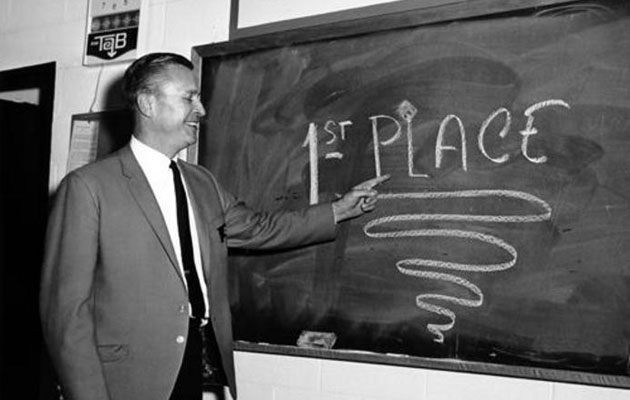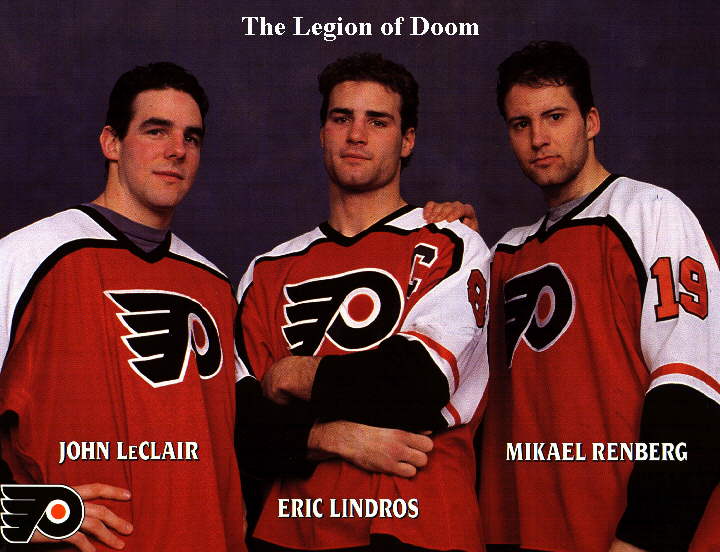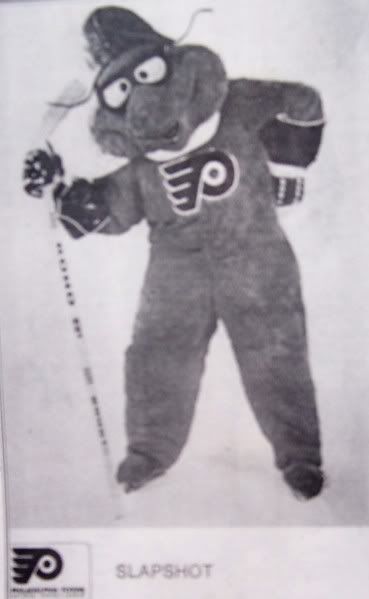Puck Daddy’s Summer Series: The Philadelphia Flyers from A to Z
(Ed. Note: August is known to be a very quiet month in the hockey world. As we wait for September to arrive and training camps to begin, let’s learn a little history about all 30 teams. Behold, our summer A-Z series, in which we ask fans of all 30 teams to drop some knowledge on us! Add your own choices in the comments!)
By: Mary Clarke, writer and Metropolitan editor for Along The Boards
A. Allen, Keith
I would be remiss if I didn’t start out this A to Z Guide by mentioning the first head coach of the Philadelphia Flyers and eventual Stanley Cup building general manager, Keith Allen.
In their first season, Allen coached the Flyers to a first place spot in their six team division and he went on to hold a 51-67-32 record in 150 games as Philadelphia’s bench boss. Unfortunately, Allen passed away last February, so thank you for everything you helped bring to this city, Keith the Thief.
B. Broad Street Bullies
It’s the nickname they’ve been known for throughout almost their entire existence, the Broad Street Bullies era of the Philadelphia Flyers from the early 1970s to 1980 is their most infamous and most successful throughout their entire franchise.
Led by young captain Bobby Clarke, the fists of enforcer Dave Schultz, and the spectacular goaltending from the greatest Philadelphia netminder of all time in Bernie Parent, the Flyers won back-to-back Stanley Cups during the 1973-74 and 1974-75 seasons as they enjoyed much success for themselves, and much animosity from others.
The Broad Street Bullies name and legacy has carried on through the seasons since, often used either as a source of pride by fans or scorn from rivals, and it will forever remain the Flyers’ most significant era to date.
C. Cinderella Run (2010)
The Flyers’ 2010 playoff run is almost as Cinderella of a run as you can get. What started with beating the New York Rangers in a shootout 2-1 in a winner take all game to advance to the playoffs continued into a playoff run that rivaled any Hollywood script.
The history making comeback from three games down in Eastern Conference Semifinal against the Boston Bruins could only have ended with the Flyers coming back from a three goal deficit to win Game 7 4-3. Even Patrick Kane’s final goal in the Stanley Cup Final against the Chicago Blackhawks was a, sadly, fitting end to one of the most remarkable runs in NHL history.
Thankfully, the Flyers miraculous run gave us this beauty of a TV spot during the NHL’s best playoff commercial series in recent memory.
D. Desjardins, Eric
Eric Desjardins is certainly one of the Flyers all-time greats. The former captain manned Philadelphia’s blue line for 11 seasons and amassed 396 points in 738 games played, ranking second among Flyers’ defensemen in team history.
Dejardins won seven Barry Ashbee Trophies, given to the Flyers’ best defenseman at the end of every season, during his tenure with Philadelphia and was just inducted into the Flyers Hall of Fame last February. There was never anything flashy about Dejardins’ game, but he was certainly one of Philadelphia’s most solid defensemen to ever guard the blue line.
E. Eugene “Gene” Hart
Gene Hart is often heralded as the original voice of the Philadelphia Flyers and was the man that gave us the iconic “Ladies and gentlemen, the Flyers are going to win the Stanley Cup!” call after their first Stanley Cup win in 1974.
Hart called over 2,000 NHL games during his 28 year play-by-play career, and started the Philadelphia broadcasting tradition that makes us all hungry of “he scores for a case of Tastycake!” after every goal call. He often finished his broadcasts in similar iconic fashion, sending off his audience with the wonderful reminder of “good night, and good hockey.”
F. Fog and the bat
The Flyers have been a part of some wacky moments in Stanley Cup Final games (looking at you, Patrick Kane) but one of the most outrageous comes from their 1975 run. Game 3 of the 1975 Stanley Cup Final against the Buffalo Sabres had the added addition of a low hanging fog in Buffalo Memorial Auditorium thanks to the arena’s lack of air conditioning on a hot May day.
The fog was so thick at times, players, fans, and even officials had a hard time following play and stoppages had to be called to try and clear it away. If that wasn’t enough, the game became the first and only time a player killed an animal during a game, after Buffalo Sabre Jim Lorentz killed a bat that was flying around the ice with his stick.
G. God Bless America
Many teams have their long-standing anthem traditions, but the Flyers forgo the Star Spangled Banner all together for a unique rendition of God Bless America during select games. The tradition started back in the 1969-70 season, when a recording of famous vocalist Kate Smith was played before a mid-December game, and the Flyers won. Since then, Kate Smith’s vocals have been implemented in times of need, during their Stanley Cup runs or big playoff games, and the singer herself has appeared multiple times during the mid-70s to sing live before puck drop.
Now, the song continues today with Lauren Hart, Gene Hart’s daughter, accompanying the recording of Kate Smith with the tradition to-date holding an outstanding record of 97-28-4 according to flyershistory.com.
H. Hextall, Ron
Our fearless general manager Ron Hextall has been a part of Flyers’ history for the past few decades. From being the first goaltender to score a goal on an empty net in 1988 to his known aggressive netminding tendencies that gave him an NHL goaltending record for 113 penalty minutes in a season, Hextall remains one of Philadelphia’s top goalies. A rookie at age 22, Hextall was awarded the Vezina Trophy and the Conn Smythe Trophy for helping take the Flyers to the Stanley Cup Final, despite losing in seven games to the Edmonton Oilers. Hextall remained a crucial part of the Flyers organization during his time as a goaltender till now as the team’s GM, and is also a wonderful source of reaction gifs for all Philadelphia sports fans.
I. Ilya Bryzgalov
Space cadet Ilya Bryzgalov deserves a special spot on this list. While mostly insignificant in his role with the Flyers, outside of commandeering an albatross of a contract that started a lot of today’s current cap problems while going from seemingly brilliant to maddeningly poor in net, Bryz won over a tiny place in many hearts due to his enigmatic personality that helped spark many a meme. From bears to huskies and everything in between, Mr. Universe’s two seasons with the Flyers were as entertaining of a story as you can find, both on and off the ice.
J. Jerseys
For a team with so much history, it’s surprising that the Flyers uniforms have changed very little over the years. Of course there was the chrome outlined logo of the early to mid-2000s and the awful 80s Cooperall pants trend, but Philadelphia has essentially maintained the same look throughout their history: orange, black, and white with the winged flying “P” crest. The main jersey color has changed, with the home uniform going from white to black and finally to orange, but if anything, the biggest difference and most revolutionary detail is their use of a colored nameplate on the back of their current jerseys.
K. Keystone State Rivalry
It’s perhaps the greatest rivalry in all of sports, or at least the most intense feud between geographic neighbors. The Philadelphia Flyers and the Pittsburgh Penguins have been rivals since their inductions into the NHL in 1967. Though the rivalry has ebbed and flowed since its start, it’s picked up steam since the 2004-05 lockout after the Penguins acquired Sidney Crosby from the lottery draft. It’s a rivalry full of bad blood and of teams and fanbases that just don’t like each other one bit, from yesterday’s Eric Lindros versus Mario Lemieux to today’s Claude Giroux and Sidney Crosby.
Thankfully, the Flyers have come out on top of this rivarly so far, holding a 150-93-30 record against the Pens while essentially owning Pittsburgh at home in Consol Energy Center 13-2-1. Even better? The Penguins haven’t beaten the Flyers since October of 2013.
L. Legion of Doom
The Legion of Doom line of John LeClair, Eric Lindros, and Mikael Renberg was the Flyers most productive trio of forwards for three seasons in the mid to late-1990s.
Nicknamed for their offensive prowess and their hard hitting physical play, the Legion of Doom produced 796 points in 679 regular season games played while wracking up 776 penalty minutes. For two of the three members, the Legion of Doom line served as a springboard to later Flyers greatness, as LeClair and Lindros remain two of the best, and most beloved Philadelphia Flyers to date.
M. Mascot?
Yes, the Flyers once had a mascot briefly in 1976. Wearing what looks to be an aviator hat, glasses and scarf combo with the logo emblazoned on his chest, Slapshot would have fit right in with the Philadelphia Flyers due to the obvious flier pun. Thankfully, this experiment didn’t last long, as Slapshot only stuck around for one season. Trust me guys, the Phillie Phanatic doesn’t need anymore friends.
N. No Stanley Cups since 1975
For all the success the Flyers have had over the course of their history, the Stanley Cup has eluded them since their last meeting in 1975. It’s been a source of great derision and hilarious Twitter trolling for fans and rivals alike. Of course, the Flyers most recent attempt ended with the start of a Chicago Blackhawks dynasty in what was possibly the worst goal given up in a Stanley Cup Final game ever. Whether it be a sore spot for some fans, or a source of motivation for others, despite being one of the NHL’s top regular season winning franchises, the Flyers have been Cup-less since #1975.
O. Overtime, Overtime, Overtime, Overtime, Overtime
Clocking in at 92:01, the Flyers were a part of — and won — the historic quintuple overtime matchup against the Pittsburgh Penguins in the 2000 playoffs. The 5OT win is the third longest in NHL history and sits as the longest in the post-lockout era. Keith Primeau scored the game winner on a fantastic solo effort, cutting in from the right circle to put home a top shelf wrist shot past Pittsburgh goaltender Ron Tugnutt to tie the series at two. Primeau’s overtime goal sparked the Flyers to win the next and final two games of the series to beat the Penguins in the Eastern Conference Semifinals.
P. Parent, Bernie
Bernie Parent is without a doubt Philadelphia’s greatest goaltender in franchise history, if not one of the greatest goaltenders period. Parent went back and forth between the Flyers and the Toronto Maple Leafs, before ultimately settling in Philadelphia to help the team win their back-to-back Stanley Cups, earning both the Conn Smythe and Vezina Trophies in those years. In the Flyers’ first Stanley Cup run, Parent locked down a 1.89 GAA in 73 games played of a 78 game season. Since then, it became well known that only the Lord saves more than Bernie Parent.
Q. Quakers, The
Believe it or not, the Flyers were not Philadelphia’s first NHL team. In fact, Philadelphia had an NHL team for one year during the 1930-31 season. The now-defunct Quakers started in Pittsburgh as the Pirates, but moved to Philadelphia after struggling out west. They didn’t fair any better across the state, managing to go 4-36-4 and today still holding the record for the fewest wins in an NHL season. Despite the lost season, the Flyers did adopt the Quakers colors of orange and black once they were officially founded as an expansion team.
R. Red Army Game
At the height of Philadelphia’s Broad Street Bully days, the Flyers accomplished another feat, beating the Soviet Union Red Army Team. In an international exhibition match played at the Spectrum, the Flyers bullied (see: V. Van Impe) their way to a 4-1 victory against what many considered to be an unbeatable machine. The Flyers were the first and only team to beat the Red Army during their North American tour as a part of the NHL’s Super Series with other Soviet Union teams.
S. Shift(s), The (Richards against the Canadiens in 2010, Giroux in 2012 against the Pens)
The Flyers had two iconic shifts just over two years apart that helped end their respective playoff series, one from the captain back then in Mike Richards and one from the soon to be captain in Claude Giroux.
Richards’ shift came in Game 5 of the Eastern Conference Final versus the Montreal Canadiens during their historic Stanley Cup Final run. The captain not only had a huge hand in the penalty kill, but he also scored the ridiculous short handed goal that helped the Flyers win the game and the series.
Giroux’s shift capped off the equally crazy 2012 Eastern Conference Quarterfinal against the Penguins, lifting the Flyers to a series victory over their rivals by taking out Sidney Crosby on a check to open the game and scoring the game winning goal just 32 seconds into the match.
T. Timonen, Kimmo
As if this one could be anything else. Kimmo Timonen is one of the most beloved Philadelphia Flyers to ever put on a uniform. Though the team could never bring him a Stanley Cup during his tenure, the veteran defenseman was an iconic staple of the Flyers’ blue line through his seven seasons with the club. Kimmo finally got his Cup with the Chicago Blackhawks this past season after blood clots kept him off the ice almost for good, but he will forever remain a Flyer, no matter what jersey he wears.
U. Unbeaten Streak
The 1979-80 Philadelphia Flyers own the mantle of holding the longest unbeaten streak in North America with 35 games without a loss, winning 25 games and tying in 10 over the course of three months. The streak started on October 14 with a 4-3 win against the Toronto Maple Leafs and ended with a 7-1 loss to the Minnesota North Stars on January 7. While the Flyers ended up on top of the Patrick Division that year, ultimately they lost out to the New York Islanders in six games in the Stanley Cup Final.
V. Van Impe, Ed
Ed Van Impe was a part of the Broad Street Bully era, and was most known for his hit that sparked the Soviet Union’s sudden departure in the Red Army Game. In an unforgettable incident, a body check from the defenseman knocked out opposing player Valeri Kharlamov flat on the ice. Red Army head coach Konstantin Loktev then pulled the team from the ice for 17 minutes after the officials did not issue a penalty and were only brought back out onto the ice after being told their salary from the game would be forfeit if they did not return.
W. “Win today, and we walk together forever.”
Head coach Fred Shero’s legacy with the Philadelphia Flyers is an impressive one, as he led the Flyers during their Broad Street Bully era and coached them to their only two Stanley Cup wins. “The Fog” held an impressive .642 winning percentage while he was head coach of the Flyers through seven seasons, leaving behind a 308-151-95 record in Philadelphia. Shero’s most famous act came in before Game 6 of the 1974 Stanley Cup Final, where he wrote his now famous quote on a chalkboard: “Win today, and we walk together forever.”
X. X Marks the Puck?
Michael Leighton wasn’t the only person who couldn’t find the Chicago Blackhawks’ game-winning puck after Game 6 of the 2010 Stanley Cup Final. Earlier in the Final, Flyers captain Chris Pronger stole the game pucks after the first two games of the series, taking the heat off his teammates after losing the matches.
Then, after Patrick Kane’s strange goal to win the Cup for the Blackhawks, the game winning puck disappeared. Many places have tried to find the vanished puck, even this website, and many believed it to be linesman Steve Miller who lifted the tiny piece of history. While it was most likely just a case of an unfortunate misplacement, the conspiracy surrounding the missing puck was never solved. Also unfortunately, the Flyers still lost the series.
Y. Youth Movement
While today’s Philadelphia Flyers are still trying to build a competitive, Stanley Cup winning team, the thing that has most fans excited is their young defensive prospects. After drafting one of the top defensemen in this year’s draft in Ivan Provorov at No. 7, Philadelphia has one of the deepest defensive prospect pools its had in decades. Provorov joins former Union star Shayne Gostisbehere, Chris Pronger look-alike Samuel Morin, dark horse first round pick in the 2014 draft Travis Sanheim, and Swedish lefty Robert Hagg. While this season’s defensive lineup for the Flyers still remains sub-par, the bright future is, thankfully, almost here.
Z. Zac Rinaldo
IS NO LONGER A FLYER GOODBYE
Meet the author: Mary Clarke is a Philadelphia Flyers writer and Metropolitan Editor for Along The Boards. Philadelphia sports has always been in her blood, but hockey and the Flyers are her true calling, possibly to the unfortunate detriment of her mental health. Follow her on Twitter @marycclarke.
Previous A to Z Guides: Anaheim | Arizona | Boston | Buffalo | Calgary | Carolina | Chicago | Colorado | Columbus | Dallas | Detroit | Edmonton | Florida | Los Angeles | Minnesota | Montreal | Nashville | New Jersey | NY Islanders | NY Rangers | Ottawa
[Yahoo Sports Fantasy Hockey: Sign up and join a league today!]
MORE FROM YAHOO SPORTS








